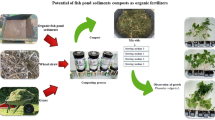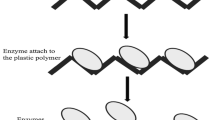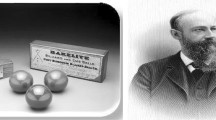Abstract
Laboratory-reared cultures of Enchytraeus crypticus were used in a reproduction toxicity test to evaluate the toxicity of 46 spoil substrates collected in four brown coal mining areas in the Czech Republic and Germany. A set of substrate parameters (pH, conductivity, Na, Ca, K, Al, Fe, loss of ignition and polyphenol contents) were measured for each spoil and correlated with spoil toxicity for E. crypticus. Toxicity increased with decreasing pH and increasing Al, Fe content. Spoil with a pH below 3 did not support the survival of E. crypticus. However, some alkaline spoils with high conductivity and ion concentration were also toxic. Toxicity was positively correlated with the loss of ignition and polyphenol content. The results indicate that the toxicity of post-mining spoil substrates have multiple origins. Most frequently the toxicity of post-mining substrates corresponds with low pH and consequent toxicity of Al and Fe. However some substrates may be toxic due to high ion concentrations. The potential role of fossil organic matter (namely polyphenols) in toxicity of post-mining substrates requires further research.
Similar content being viewed by others
References
Bradshaw, A.: 1997, ‘Restoration of mined lands – Using natural processes’, Ecol. Eng. 8, 255–269.
Crouau, Y. and Cazes, L.: 2003, ‘What causes variability in the Folsomia candida reproduction test?’, Appl. Soil Ecol. 22, 175–180.
Donkin, S. G. and Dusenbery, D. B.: 1993, ‘A soil toxicity test using the nematode Caenorhabditis elegans and an effective method of recovery’, Arch. Env. Contamin. Toxicol. 25, 145–151.
Düker, C., Keplin, B. and Hüttl, R. F. 1999. ‘Development of enchytraeid communities in reclaimed lignite mine spoil’, Newslett. Enchytr. 6, 77–89.
Dunger, W.: 1991, ‘Zur Primärsukzession humiphager Tirgrupen auf Bergbauflächen’, Zool. Jahrb. Syst. 118, 423–447.
Frouz, J.: 1997, ‘Changes in communities of soil dwelling dipteran larvae during secondary succession in abandoned fields’, Eur. J. Soil Biol. 33, 57–65.
Frouz, J., Keplin, B., Pižl, V., Tajovský, K., Starý, J., Lukešová, A., Nováková, A., Balík, V., Háněl, L., Materna, J., Düker, C., Chalupský, J., Rusek, J. and Heinkele, T.: 2001, ‘Soil biota and upper soil layers development in two contrasting post-mining chronosequences’, Ecol. Eng. 17, 275–284.
Galli, R., Munz, C. D. and Scholtz, R.: 1994, ‘Evaluation and application of aquatic toxicity test – Use of the microtox test for prediction of toxicity based upon concentrations of contaminants in soil’, Hydrobiologia 273, 179–189.
Gensemer, R. W.: 1991, ‘The effect of pH and aluminium on growth of the acidophilic diatom Asterionella ralfsii var. americana’, Limnol. Ocenaogr. 36, 123–131.
Hamouz, K., Lachman, J., Pivec, V. and Orsák, M.: 1997, ‘The effect of the conditions of cultivation on the content of polyphenol compounds in the potato varieties Agia and Karin’, Plant Product. 43, 541–546.
ISO 16387: 2003, (E), ‘Soil quality – effects of pollutants on Enchytraeidae (Enchytraeus sp.) – determination of effects on reproduction and survival’.
Jenner, H. and Janssenmommen, J. P. M.: 1993, ‘Duckweed Lemna minor as a tool for testing toxicity of coal residues and polluted sediments’, Arch. Env. Contamin. Toxic. 25, 3–11.
Keplin, B., Düker, C., Kielhorn, K. H. and Hüttl, R. F.: 2000, Ökologisches Entvicklungspotential der Bergbaufolgelandschaften im Niederlausitzer Braunkohlerevier, Springer, Leipzig, pp. 319–325.
Posthuma, L., Noteboom, J., de Groot, A. C. and Peijnenburg, W. J. G. M.: 1988, ‘Soil acidity as a major determinant of zink partioning and zink uptake in oligochaete worms exposed in contaminated field soils’, in S. Sheppard, J. Bembridge, M. Holmstrup and L. Posthuma (eds), Advances in Earthworm Ecotoxicology, SETAC Press, Pensacola, pp. 111–127.
Römbke, J., Moser, T. and Knacker, T.: 1998, ‘Enchytraeid reproduction test’, in S. Sheppard, J. Bembridge, M. Holmstrup and L. Posthuma (eds), Advances in Earthworm Ecotoxicology, SETAC Press, Pensacola, pp. 83–97.
Römbke, J. and Moser, T.: 1999, ‘Report on an International Ringtest with the Enchytraeid reproduction test’, UBA-Rext 4/99, 373.
Sample, B. E. and Suter, G. W.: 2002, ‘Screening evaluation of the ecological risks to terrestrial wildlife associated with a coal ash disposal site’, Hum. Ecol. Risk Assess. 8, 637–656.
Schins, R. P. F. and Borm, P. J. A.: 1999, ‘Mechanisms and mediators in coal dust induced toxicity: A review’, Ann. Occup. Hyg. 43, 7–33.
Sharmasarkar, S. and Vance, G. F.: 1997, ‘Kinetics of selenomethionine disappearance from reclaimed coal mine soils of Wyoming, USA’, Env. Geol. 29, 202–208.
Spurgeon, D. J. and Weeks, J. M.: 1998, ‘Evaluation of factors influencing results from laboratory toxicity test with earthworms’, in S. Sheppard, J. Bembridge, M. Holmstrup and L. Posthuma (eds), Advances in Earthworm Ecotoxicology, SETAC Press, Pensacola, pp. 15–25.
Trublaevich, Z. N. and Semenova, E. A.: 1997: ‘Estimation of soil toxicity using a laboratory culture of springtails (Folsomia candida)’, Russian J. of Ecol. 28, 335–339.
Van Gestel, C. A. M.: 1992, ‘The influence of soil characteristics on the toxicity of chemicals for Earthworms: A review’, in P. W. Greig-Smith, H. Becker, P. J. Edwards and F. Heimbach (eds.), Ecotoxicology of Earthworms, Intercept, Andover, pp. 44–54.
Van Gestel, C. A. M. and Hoogerwerf, G.: 2001, ‘Influence of soil pH on the toxicity of aluminium for Eisenia andrei (Oligochaeta: Lumbricidae) in an artificial soil substrate’, Pedobiologia 45, 385–395.
Westheide, W. and Bethke-Beilfuss, D.: 1991, The sublethal enchytraeid test system: Guidelines and some results”, in G. Esser and D. Overdieck (eds), Modern Ecology Basic and Applied Aspects, Elsevier, Amsterdam, pp. 497–508.
Westheide, W., Bruggl, G. and Stille, A.: 1993, Zu Weiterentwicklung und ökologishe Bewertung des Enchytreen-Tesverfahrens, Bedeutung subtoxisher Belastung für das Fretland”, Abschlussbericht zum Forschungsarbeit 0339287 A, ösnabrück.
Author information
Authors and Affiliations
Corresponding author
Rights and permissions
About this article
Cite this article
Frouz, J., Krištůfek, V., Bastl, J. et al. Determination of Toxicity of Spoil Substrates After Brown Coal Mining Using a Laboratory Reproduction Test with Enchytraeus crypticus (Oligochaeta). Water Air Soil Pollut 162, 37–47 (2005). https://doi.org/10.1007/s11270-005-5991-y
Received:
Accepted:
Issue Date:
DOI: https://doi.org/10.1007/s11270-005-5991-y




